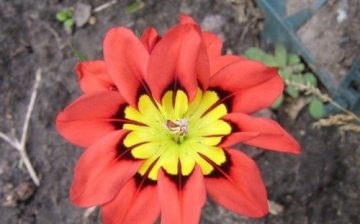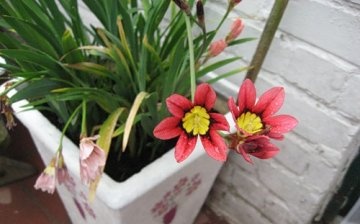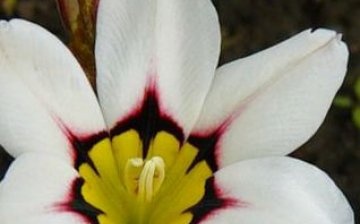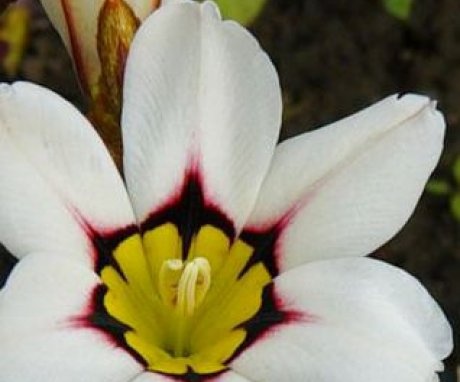Planting and caring for sparaxis is troublesome
A perennial called sparaxis is dear to the hearts of many flower growers due to its elegant and bright appearance. Small funnel-shaped or star-shaped flowers of this plant, located on long thin stems, are, as it were, divided into three parts: a bright outer edge, a contrasting middle and a thin border separating them, almost always having a rich black color. The color of the flowers is white, bright red, orange or yellow. Sparaxis pleases the eye with its flowering from late May to late June.
Content:
Biological description
Sparaxis is one of the members of the iris family. In Africa, the country from which he came to us, the flower grows up to a meter. In our conditions, its growth does not exceed 60 centimeters, dwarf varieties have a height of only 15 centimeters.
Despite the fact that in its homeland sparaxis is a perennial, in our country it is most often grown as an annual because of the harsh winters to which the tropical flower is not used.
The name of this flower seems pretentious, but in fact it is based on the Greek word "sparax", which means bracts, split at the ends.
Unfortunately, this flower is very moody, and planting and caring for sparaxis is more than troublesome.
But what joy will you get if this plant takes root on your site to the envy of everyone around you.
Sparaxis care
However, if certain rules are followed, planting and caring for sparaxis can be quite successful. So, first you should remember that this plant, whose homeland is sultry Africa, is very thermophilic, therefore the slightest cold is destructive for it. In areas with a cool climate, it can be grown exclusively in greenhouses and greenhouses (as an option, on heated loggias in large boxes): in the open field, sparaxis will die at the first drop in temperature.
In warmer areas, the plant does much better and takes root relatively well in open soil.
Sparaxis grows best in rich yet well-drained loams in warm, sunny areas. Therefore, when planting a plant, peat must be added to the soil.
Sparaxis needs regular and abundant wateringespecially during a drought. It is also recommended to spray the plant, since in its homeland it is accustomed to high humidity. But do not overdo it, as excess moisture can lead to decay.
The plant needs monthly feeding mineral fertilizers: 15-20 grams of fertilizer is dissolved in a bucket of water.
The optimum temperature for sparaxis is + 15-20 degrees. At temperatures below +7 degrees, the plant dies. But at the same time, it does not tolerate very high temperatures.
Sparaxis is picky about lighting. In the shade, it does not bloom or blooms very weakly.
In order not to spoil the decorative appearance of the flower, faded peduncles and damaged branches should be removed.
Reproduction
Sparaxis is propagated by corms, seedlings and seeds.
The plant should be planted to a depth of about eight centimeters so that there is about fifteen centimeters of free space between adjacent bulbs.
It is better not to plant seeds in open ground due to the low probability of germination.It is recommended to sow them in indoor pots. When the seedlings reach a height of 7-10 centimeters, they can be transplanted into open ground.
Seedlings are planted at a distance of 15 centimeters. If you plan to use cut flowers, then the distance between the plants should be 40-50 centimeters. It is best to plant sparaxis in a large group of 80-100 plants.
When combined with other plants, sparaxis is placed in the foreground. It looks perfect on flower beds, borders, rock gardens, balconies, terraces, flowerpots and hanging containers. Sparaxis is also suitable for making bouquets.
Pests and diseases
From hypothermia of the soil and stagnant water in sparaxis, the roots often rot. To prevent rotting, it is recommended to add drainage to the soil.
The plant can infect chlorosis. In this case, treat it with an iron chelate.
Wintering
Before the first frosts, it is advisable to dig up the sparaxis bulbs and store them in a cool place at a temperature of 5-10 degrees in winter, placing them in peat, sawdust or moss. They can be stored for several years. In the southern regions, it is not necessary to dig up a plant for the winter: it is enough just to cover it with foliage.
Forcing Sparaxis
Despite its finickyness, sparaxis feels good in indoor conditions and is quite suitable for winter distillation.
Place 5-6 in one pot bulbs... The soil is prepared from earth, sand and peat. After planting, the bulbs are watered with mineral fertilizer.
Caring for a plant planted in a room is the same as when planting in an open ground.














What an amazing flower! very beautiful and also very moody! Probably, only an experienced florist will decide to grow it.
I bought seeds, sowed them. They came out well. We will look further, how they will develop.